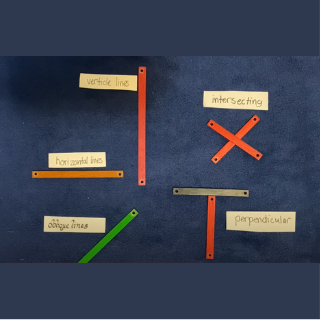
This video lesson is designed for 6 to 12-year-old children. In this geometry lesson, we will be learning about the different types of lines and their usage in our daily life.
What is a Line?
A line is a one-dimensional geometric shape that extends infinitely in both directions, made up of a set of points. It is determined by two points on a two-dimensional plane. Collinear points refer to two points that lie on the same line. Different types of lines, such as horizontal, vertical, parallel, and perpendicular lines, play a crucial role in constructing various polygons. For example, an almirah is constructed from four lines with two different lengths joined together.
In our daily life, we all see objects having different types of lines in our surroundings – For example, corners of the wall, stairs, roads, school, notebooks, etc.
What are the 8 Different Types of Lines?
Lines are a fundamental element of objects in our daily life. They can be used in a variety of ways to create different objects, construction, and infrastructures. In this video, we will discuss 8 such types of lines:
- Horizontal Line.
- Vertical Line.
- Perpendicular line.
- Intersecting lines.
- Oblique Lines
- Divergent lines.
- Convergent Lines.
- Parallel Lines.
This video is divided into two parts.
- In part one, horizontal, vertical, perpendicular, intersecting, and oblique lines are described using bars.
- In the second part, divergent, convergent, and parallel lines are explained as a story using human cutouts.
Let us understand these 8 different types of lines:
What is a Horizontal Line?
A line that is parallel to the x-axis is called a horizontal line. In other words, A horizontal line is a straight line that extends from left to right. It is also called a sleeping line. For example, In daily life, horizontal lines are commonly used in clothing to create a sense of width and stability, such as in horizontally striped shirts or jackets, low, wide bookcases or horizontal paintings, the length of a table, a building, a notebook, etc.
What is a Vertical Line?
A line that is parallel to the y-axis is called a vertical line. In other words, it is a straight line that extends from top to bottom. It is also called a standing line. For example, vertical lines are used in architecture to create a sense of grandeur. In daily life, vertical lines are commonly used in clothing to create a sense of length, such as in pinstriped suits or vertically striped shirts, floor-to-ceiling curtains, or tall, narrow bookcases, the height of the wall or a fence, etc.
What is a Perpendicular Line?
When two lines intersect each other at a given point and the angle formed between them is 90 degrees, they are said to be perpendicular to each other. In daily life, perpendicular lines are commonly used in architecture and building construction to create right angles. For example, the corners of a room or the sides of a door frame are often made perpendicular to each other to ensure stability and balance. Perpendicular lines are also used in geometry to determine the relationship between different shapes and angles.
What is an Oblique Line?
A straight line that is neither horizontal nor vertical is called an oblique line. It is commonly used in design to create a sense of movement or direction. It is also called a slanting line. For example, in daily life, oblique lines can be seen in various forms, such as in the design of road signs, where diagonal lines are used to indicate direction or movement. They can also be used in clothing design to create visual interest and depth, such as in diagonal stripes or patterns.
What is an Intersecting Line?
When two or more lines cross or intersect another line at a particular point, these lines are known as intersecting lines. For example, in daily life, intersecting lines can be seen in various forms, such as in the design of road signs, in the construction of buildings, or in a pair of scissors. They are commonly used in geometry to determine the relationship between different shapes and angles.
What is a Parallel Line?
When two lines do not meet at any point in a plane surface and are said to be parallel to each other. They are equidistant from each other at all points. It is also used to create symmetry and balance in the design. As shown in the video, the two human cutouts never meet each other. Real-life examples are railway tracks or a stack of identical books, etc.
What are Convergent Lines?
Two lines are said to be convergent when their ends are in close proximity. It means they will meet at a point when we get closer and closer towards the end. For example, the perspective of the railway track, or road, etc.
What are Divergent Lines?
When two lines move in different directions from a common point, they are said to be diverging from each other. For example, a flowing river from a mountain, sun rays falling on the ground, etc.
Watch the video to know more about different types of lines and find them around yourself.
Related Video Lessons:
For more math resources, click here.
Video Created by: Justine McNeilly
FAQs
- What is a line?
A line is defined as a straight, one-dimensional figure that extends infinitely in both directions.
- What are 8 types of lines?
There are eight types of lines: vertical, horizontal, perpendicular, oblique, convergent, divergent, intersecting and parallel lines.
Tags
- Elementary
- English
- Geometry
- Math





